Coronavirus and eCommerce Per Country: How Less Virus Means More Sales
by Wei-Shin Lai, MDOctober 30, 2020
Now that we are at least 6 months into the COVID-19 pandemic with cases in 140 countries, our company has collected enough data to see how the virus changed SleepPhones® headphones ecommerce worldwide.
A Bit of Background
We sell SleepPhones® headphones, the world's most comfortable headphones for sleeping. Our brand is the original sleep headphone, most advanced technology, and leads the category of headphones you can wear in bed. We ship around the world from our headquarters in Erie, PA. Since starting our company 13 years ago, we have tracked who visits our website, how much time they spend on the website, and who makes a purchase. Patterns shift as countries go through upheaval, get richer/poorer, and weather a pandemic.
How Events Around The World Are Affecting Business
As small business owners, we follow geopolitics to understand shifting market patterns to coordinate our response. For example, we've been affected by Brexit, the trade war with China, India's currency reissue, Hong Kong's democracy protests, Australian wildfires, and various trade deals. Running this business shows us just how small the world is and how much we all depend on each other.
The pandemic is the first time we've seen a serious worldwide phenomenon affect everyone during roughly the same time period. Of course, every country has a different approach to the virus, with widely varying results. The pandemic isn't over yet, and we seem to be heading into the worst of it right now, as cases spike in Western Europe, Midwestern US, and India. As the virus sweeps through, people's attention and purchase patterns change. Analyzing this current situation helps us as a business plan for future worldwide catastrophes, such as wars, climate disasters, and economic recession.
My Medical Background
Of note, I am a medical doctor with an interest in infectious diseases and epidemiology. I was once offered a CDC Epidemic Intelligence Service Officer position. I have blogged, spoken, and been interviewed throughout this pandemic. I stopped practicing medicine six years ago to focus on the SleepPhones® business.
eCommerce Data Before and During the COVID-19 Pandemic
SleepPhones® Sales Data
First, we compared website interest and ecommerce sales data from before the pandemic (2019) and for the past six month period (April-September 2020). During this "pandemic period," every nation had community spreading of COVID-19. Since we are analyzing the percent change before and during the COVID-19 pandemic, we set a minimum number of orders so that the data isn't skewed due to the law of small numbers. Plus, we want to focus our attention on the most profitable countries. There were a total of 30 countries which met the criteria for inclusion into the analysis.
Increase vs. Decrease in Interest for SleepPhones®
Next, we ranked the change in ecommerce interest for SleepPhones® headphones. This is the column labelled "Change in e-commerce interest for SleepPhones®" in the spreadsheet below. We wanted to find out if we should change advertising strategies or shipping methods for certain regions around the world. Surprisingly, there was no consistent trend. There are green dots (increased interest) and red dots (decreased interest) in all regions.
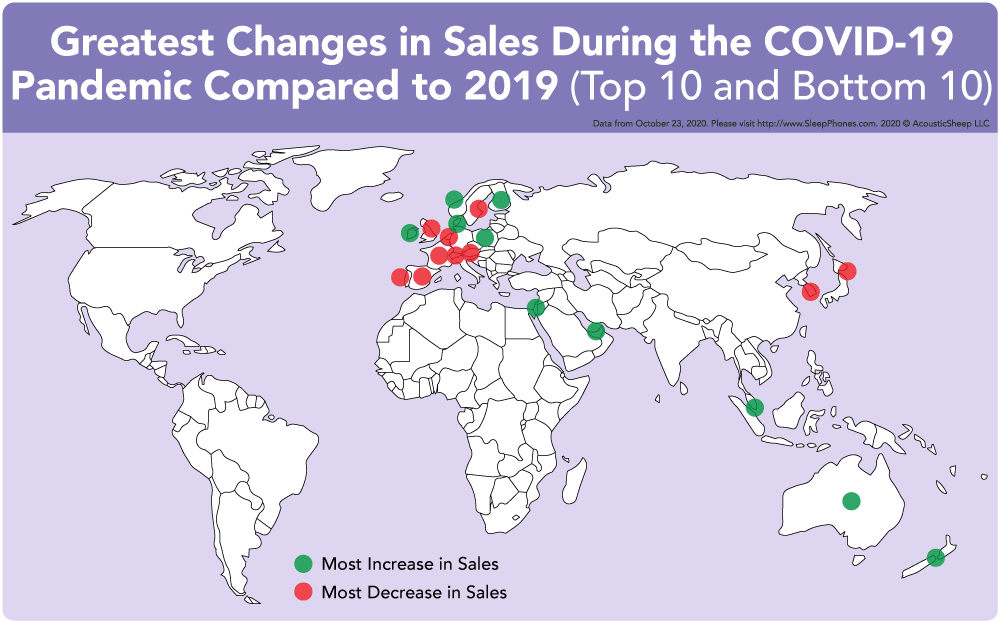
However, we have not observed this level of change in ecommerce from country to country in prior years. The amount of interest from each country has been remarkably consistent year after year except for specific events as alluded to above. This led us to wonder if the exact management of COVID-19 in each country is what caused the changes we see in ecommerce. In particular, we noticed that the Scandanavian countries of Norway, Denmark, and Finland have dramatically increased sales while Sweden has decreased sales. Sweden was the lone country in the region to implement the controversial herd immunity strategy, with no lockdown.
Correlating Change in SleepPhones® Sales to COVID-19
Politicians sometimes argue that improving the economy means not controlling the virus. It is painted as an either-or situation. The findings were remarkable when we looked at our own numbers, so we decided to share them with you.
As a niche business, we have to balance protecting our proprietary data with providing impactful information to you. Therefore, we decided to reveal the ten most changed in interest either positive or negative. For the ten countries in the middle, the change in interest was mostly positive and includes the United States of America, but we will not reveal the other nine countries. Ever since inventing the entire category of sleep headphones 13 years ago (a keyword that Google started tracking because of us), we have seen cheap knockoffs and well-capitalized competitors emerge. We know that they follow us, the category leader. Withholding some data helps protect our trade secrets.
In green are the countries that showed the most increase in SleepPhones interest, and in red are the countries that cooled the most on SleepPhones. You can see the exact change in interest in the second column, labelled, "Change in e-commerce interest for SleepPhones." For example, Ireland, Norway, and Australia ordered more SleepPhones during the pandemic than before. Spain, Austria, and Japan ordered less. For the most part, our ecommerce business has been good!
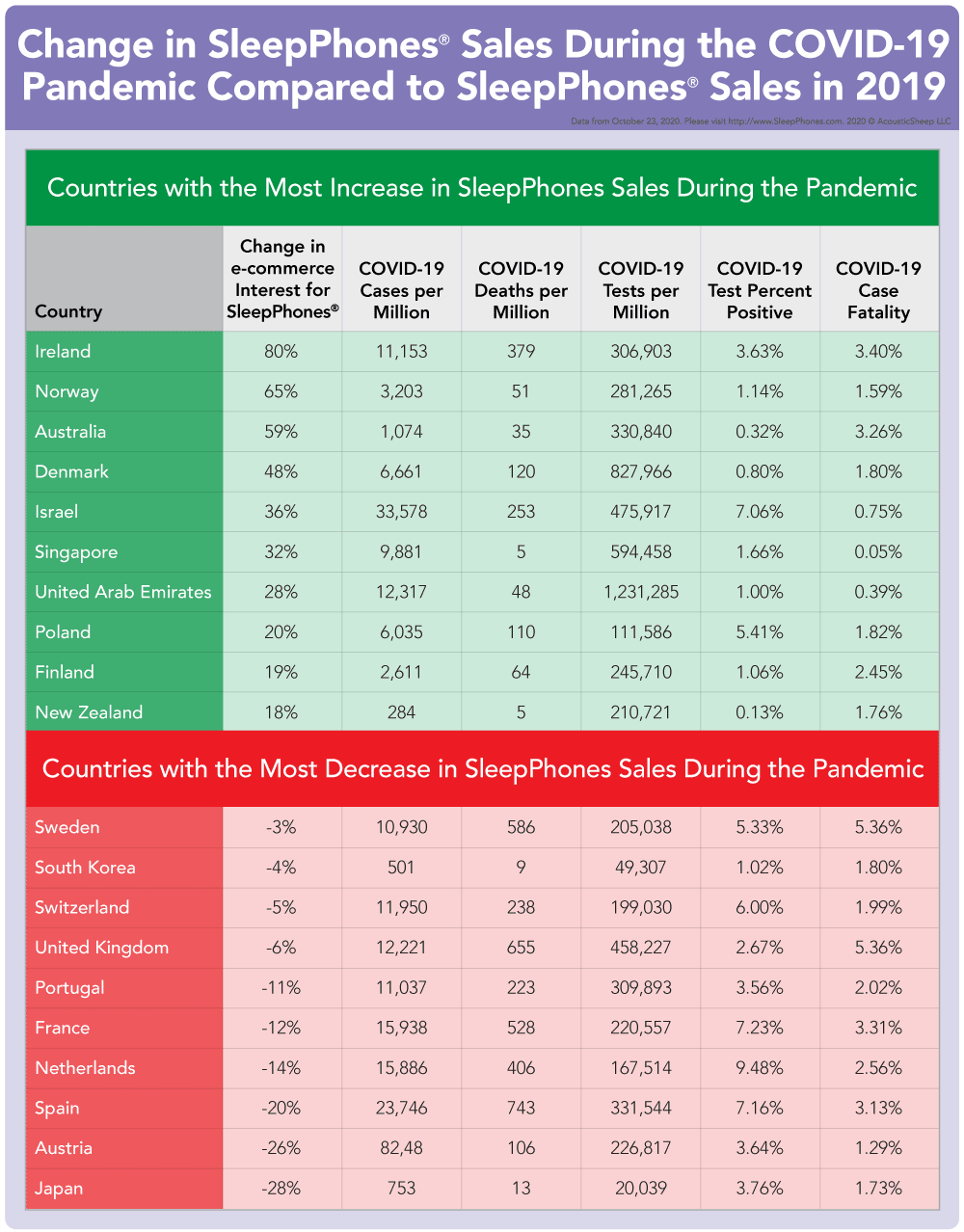
The following columns are the COVID-19 statistics for each country from Worldometer using the numbers from October 23, 2020. The Cases and Deaths columns are Cases and Deaths per million population for the country. This helps us compare apples to apples. While there are always special circumstances and outliers in any data set, we can see some clear trends when we compare the top 10 and bottom 10 countries.
The top 10 countries buying more SleepPhones during the pandemic average 8,680 cases per million. They show 40% more interest in SleepPhones during the pandemic than before. The 10 countries buying fewer SleepPhones average 11,121 cases per million. They show 13% less interest in SleepPhones during the pandemic. Fewer COVID-19 cases correlates with more SleepPhones ecommerce.
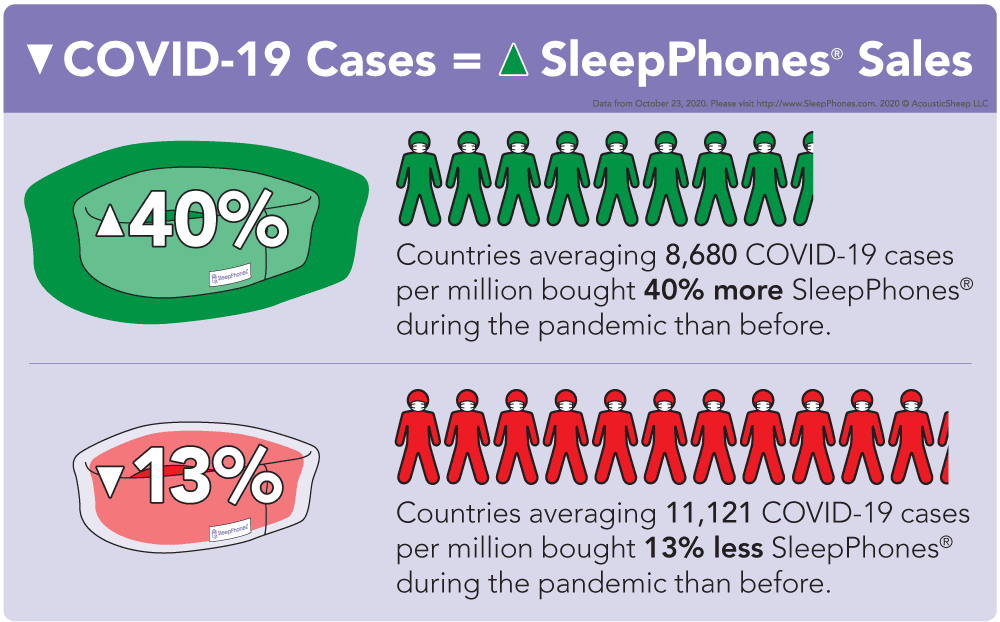
One may argue that not all cases are detected equally in all countries due to testing variations, so we should look at deaths per million. Presumably, recording of deaths due to COVID-19 would be more accurate since that is the worst outcome. Deaths per million in the countries buying more SleepPhones average 107. Deaths per million in the countries buying fewer SleepPhones average 351. Consistent with the number of cases, fewer deaths correlate with more ecommerce.
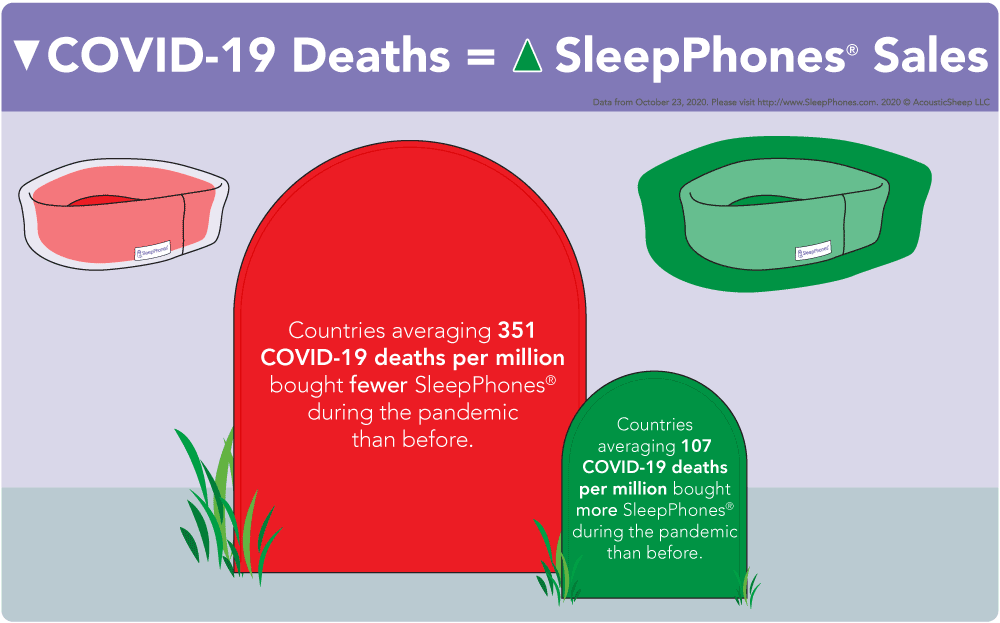
It is important to distinguish correlation from causation. Are we seeing more purchases from the countries with fewer cases because their economy is better? Or are there fewer cases because the countries switched to more online purchasing? There are surely economists who can answer these questions with more data, but we are not economists. All we have is the correlation that when we see more of one phenomenon (more purchases), we see less of another (less virus). But we do have a few other trends to help tease out the reasons.
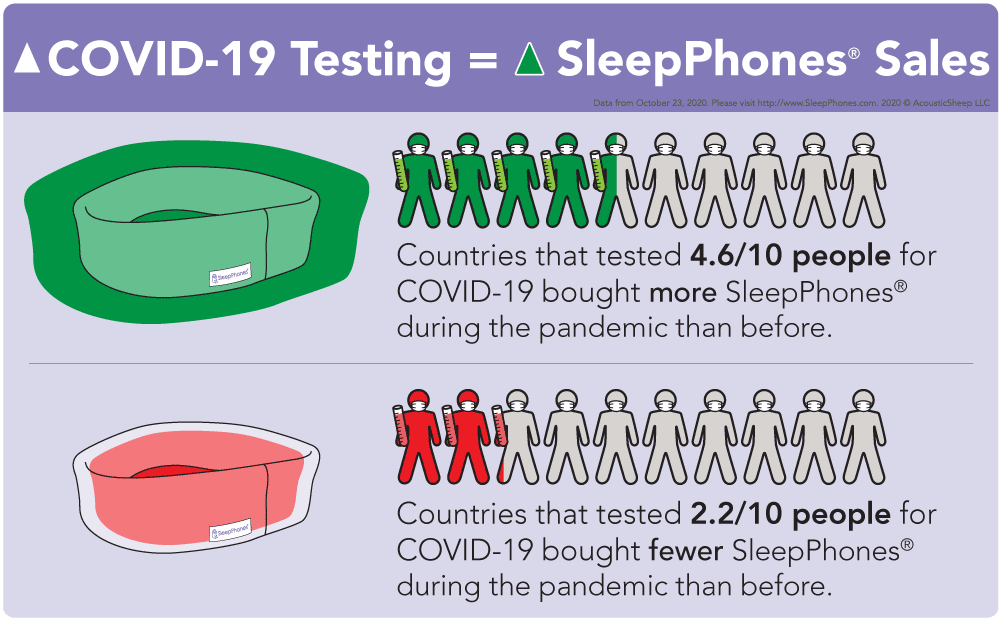
The countries buying more SleepPhones conduct twice as many tests per million as the countries buying fewer SleepPhones. The percent positivity (percent of tests returning as positive cases) for the SleepPhones-happy countries (2.2%) is half of the SleepPhones-less countries (5%). The countries making more purchases show a death rate of 1.7% compared with 2.9% for the countries buying less.
Testing rates, percent positivity, and death rates are all indicators of how well a virus is being managed by a country. The amount of people being tested reflects the priorities of the country. More testing means that there are enough resources for more testing. It also means that people want to know so they can quarantine or resume normal activity. Nearly all of the 20 countries on the list are wealthy with relatively free societies that do not force testing on their citizens. Knowing whether or not one has the virus is important for protecting society at large.

Percent positivity reveals how well the virus is controlled in communities. The CDC says that, "A high percent positivity means that SARS-CoV-2, the virus that causes COVID-19, transmission is elevated in the jurisdiction and community mitigation measures are warranted to reduce transmission." The WHO recommends a percent positivity rate of less than 5%.
Death rates reflect a country's healthcare capacity, population age, and effective use of medicines or therapeutics. Our ecommerce interest is up when testing rates are up, percent positivity is down, and death rates are down. In other words, when COVID-19 is well managed in the country, SleepPhones sales are better.
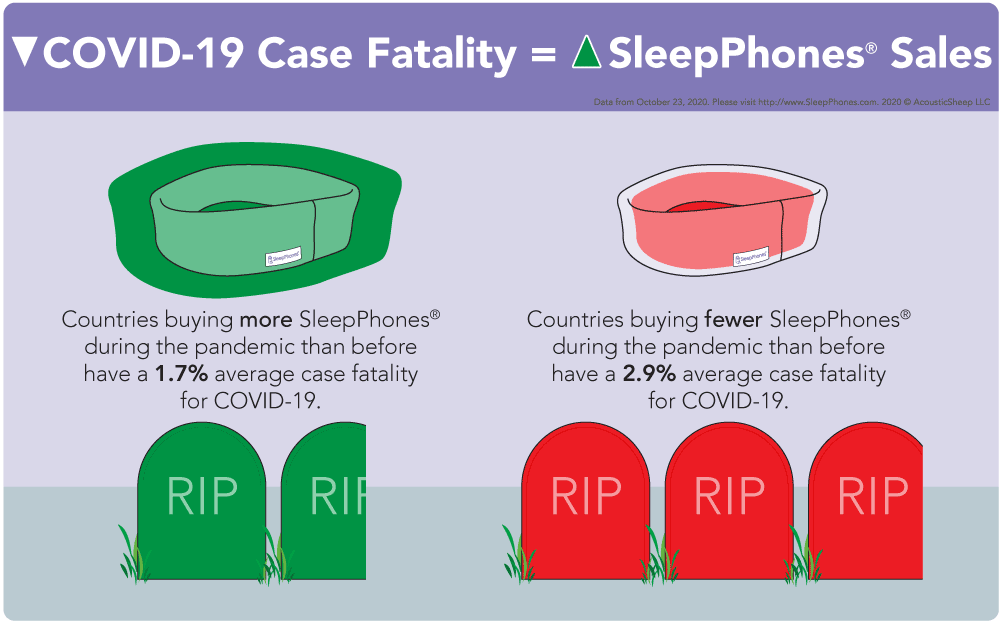
Less Virus = More Sales
There are few narratives that can tie together all of these correlations. When control of the virus improves in a country, more people are purchasing SleepPhones. Perhaps it is because of increased consumer confidence? Or maybe the economy is actually better with better virus control? Or maybe they increased their online shopping habits and are staying home more, leading to fewer cases and fewer deaths. You would think that people in countries with more COVID-19 cases and deaths would have more sleep problems, but SleepPhones ecommerce interest has less to do with sleep problems and more to do with disposable income spending power.
We may never know the exact cause and effect, since this is simply a correlation of data. But this point is certain for our business: sales are up when the virus is down. We believe this applies to most other businesses and therefore the broader economy. Less virus means more economic activity. The more we collectively stop the virus, the more we can get back to normal. Let's work on conquering COVID-19!
